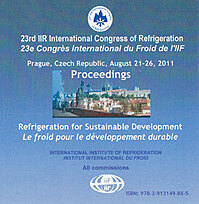
Document IIF
Le bilan énergétique, une nouvelle approche de la baisse de la consommation d'énergie.
An energy balance, a new way of approaching energy reduction.
Numéro : pap. ID: 886
Auteurs : JAMES S. J., JAMES C.
Résumé
The purpose of a food factory is to take a supply of raw materials and transform them in the most cost efficient manner into a finished packaged product. In one factory, surveyed by the authors, the input was 350 tonnes of raw fish at -20°C and 125 tonnes at 0°C, per week. The output was 400 tonnes of finished product at 3°C and 75 tonnes of waste material at 12°C. During processing the heat energy in the food and waste had therefore increased from 32 500 million kJ to 121 525 million kJ. Why did the factory use the majority of its electrical energy consumption to maintain refrigeration plants if the whole process required the food to gain heat? Initial studies revealed that there was a substantial base energy load in the factory. For example the factory used over 500 kWh of energy per hour on nights in December when the average ambient temperature was below 0°C, there was no production in the factory and all the doors were closed. Further investigations revealed that there was no relationship between throughput and energy usage. In this paper the authors look at practical methods of reducing the heat loads in such a factory and utilizing the ‘negative’ heat load in the raw material to offset the need for refrigeration.
Documents disponibles
Format PDF
Pages : 6 p.
Disponible
Prix public
20 €
Prix membre*
Gratuit
* meilleur tarif applicable selon le type d'adhésion (voir le détail des avantages des adhésions individuelles et collectives)
Détails
- Titre original : An energy balance, a new way of approaching energy reduction.
- Identifiant de la fiche : 30001743
- Langues : Anglais
- Source : Proceedings of the 23rd IIR International Congress of Refrigeration: Prague, Czech Republic, August 21-26, 2011. Overarching theme: Refrigeration for Sustainable Development.
- Date d'édition : 21/08/2011
Liens
Voir d'autres communications du même compte rendu (569)
Voir le compte rendu de la conférence
Indexation
-
Energy flow analysis of an industrial ammonia r...
- Auteurs : WIDELL K. N., SVENDSEN E. S., SELVNES H., SEVAULT A., HAFNER A., NORDTVEDT T. S.
- Date : 13/06/2022
- Langues : Anglais
- Source : 15th IIR-Gustav Lorentzen Conference on Natural Refrigerants (GL2022). Proceedings. Trondheim, Norway, June 13-15th 2022.
- Formats : PDF
Voir la fiche
-
Energy efficiency issues in process industries.
- Auteurs : LE VAN CHIN, TEDFORD J. D., BANKSAL P. K.
- Date : 11/2002
- Langues : Anglais
- Source : IRHACE J. - vol. 14 - n. 7
Voir la fiche
-
APPLICATION DE L'ANALYSE ENERGETIQUE AU TRANSPO...
- Auteurs : MACHADO P., TEIXEIRA R. C.
- Date : 1984
- Langues : Portugais
- Source : Rev. port. Frio - vol. 6 - n. 21-22
Voir la fiche
-
Simulation of a fish freezing tunnel using Mode...
- Auteurs : STAVSET O., WIDELL K. N., BANTLE M., et al.
- Date : 16/08/2015
- Langues : Anglais
- Source : Proceedings of the 24th IIR International Congress of Refrigeration: Yokohama, Japan, August 16-22, 2015.
- Formats : PDF
Voir la fiche
-
Verification of a Modelica-based dynamic simula...
- Auteurs : WALNUM H. T., ANDRESEN T., WIDELL K. N.
- Date : 21/08/2011
- Langues : Anglais
- Source : Proceedings of the 23rd IIR International Congress of Refrigeration: Prague, Czech Republic, August 21-26, 2011. Overarching theme: Refrigeration for Sustainable Development.
- Formats : PDF
Voir la fiche
